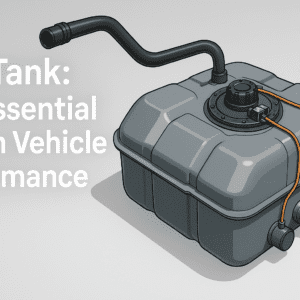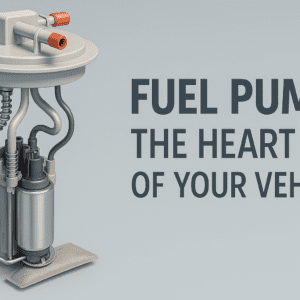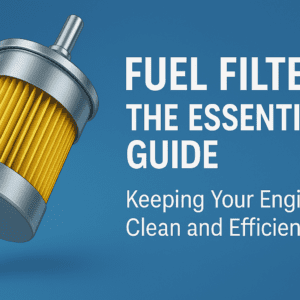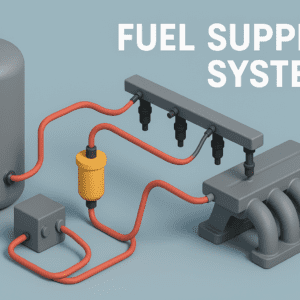
Have you ever experienced a sudden loss of power while driving, or noticed your vehicle’s engine sputtering and misfiring? These could be signs of a failing fuel pressure regulator – a small but crucial component in your car’s fuel system. 🚗💨
While often overlooked, the fuel pressure regulator plays a vital role in ensuring your engine runs smoothly and efficiently. It’s the unsung hero that maintains the perfect balance of fuel delivery, directly impacting your vehicle’s performance, fuel economy, and overall longevity. But what exactly is a fuel pressure regulator, and why should you care? 🤔
In this comprehensive guide, we’ll dive deep into the world of fuel pressure regulators. We’ll explore their function, types, warning signs of failure, maintenance tips, and the benefits of keeping this component in top shape. Whether you’re a car enthusiast or simply want to understand your vehicle better, buckle up as we take you on a journey through the heart of your car’s fuel system. 🔧🔍
Get more about engine, click on this link: Engine
Understanding Fuel Pressure Regulators

A. Definition and purpose
A fuel pressure regulator is a crucial component in a vehicle’s fuel system, responsible for maintaining consistent fuel pressure to the engine. Its primary purpose is to ensure that the engine receives the right amount of fuel at the correct pressure, regardless of varying engine conditions or fuel pump output.
The fuel pressure regulator plays a vital role in:
- Optimizing engine performance
- Maintaining fuel efficiency
- Reducing emissions
- Preventing engine damage
By precisely controlling fuel pressure, this device helps achieve the ideal air-fuel mixture for combustion, which is essential for smooth engine operation and optimal power output.
B. Key components
The fuel pressure regulator consists of several key components that work together to maintain proper fuel pressure:
- Diaphragm
- Spring
- Valve
- Vacuum port
- Inlet and outlet ports
Here’s a breakdown of these components and their functions:
| Component | Function |
|---|---|
| Diaphragm | Responds to changes in pressure and moves to adjust fuel flow |
| Spring | Provides resistance against the diaphragm to maintain a set pressure |
| Valve | Opens or closes to regulate fuel flow back to the tank |
| Vacuum port | Connects to the engine’s intake manifold to sense engine load |
| Inlet port | Receives fuel from the fuel pump |
| Outlet port | Directs excess fuel back to the fuel tank |
C. How they work in the fuel system

The fuel pressure regulator operates as part of a closed-loop system within the vehicle’s fuel delivery system. Here’s a step-by-step explanation of how it works:
- Fuel pump pressurization: The fuel pump sends pressurized fuel to the fuel rail.
- Pressure sensing: The regulator’s diaphragm senses the fuel pressure in the fuel rail.
- Pressure regulation: If the pressure exceeds the set point, the diaphragm compresses the spring, opening the valve.
- Excess fuel return: The open valve allows excess fuel to return to the fuel tank, reducing pressure in the fuel rail.
- Vacuum compensation: The vacuum port senses engine load through manifold vacuum, adjusting fuel pressure accordingly.
- Constant adjustment: This process occurs continuously, ensuring consistent fuel pressure under various operating conditions.
The fuel pressure regulator’s operation is critical for maintaining the proper fuel-to-air ratio across different engine speeds and loads. By precisely controlling fuel pressure, it helps optimize engine performance, fuel efficiency, and emissions control.
Now that we’ve covered the basics of fuel pressure regulators, let’s explore the different types available in the market and their specific applications.
Get more about lubrication system, click on this link: Lubrication System
Types of Fuel Pressure Regulators
Mechanical regulators

Mechanical fuel pressure regulators are the traditional and most common type found in many vehicles. These regulators operate using a simple yet effective spring-and-diaphragm mechanism. As fuel pressure increases, it pushes against the diaphragm, which compresses the spring. When the pressure reaches a predetermined level, the regulator opens to release excess fuel back to the tank, maintaining a constant pressure in the fuel system.
Key features of mechanical regulators:
- Simple design with fewer components
- Generally more affordable
- Reliable performance in most driving conditions
- Easier to diagnose and repair
However, mechanical regulators have limitations:
- Fixed pressure setting
- Less precise control over fuel pressure
- May struggle to maintain consistent pressure in high-performance applications
Electronic regulators

Electronic fuel pressure regulators represent a significant advancement in fuel system technology. These regulators use sensors and an electronic control unit (ECU) to monitor and adjust fuel pressure in real-time. This allows for more precise control over fuel delivery, resulting in improved engine performance and fuel efficiency.
Get more about fuel system, click on this link: Fuel System
Benefits of electronic regulators:
- Dynamic pressure adjustment based on engine load and conditions
- Improved fuel economy
- Enhanced engine performance across various driving scenarios
- Better integration with modern engine management systems
Drawbacks:
- More complex design
- Higher initial cost
- May require specialized diagnostic equipment for troubleshooting
| Feature | Mechanical Regulator | Electronic Regulator |
|---|---|---|
| Pressure Control | Fixed | Dynamic |
| Precision | Moderate | High |
| Cost | Lower | Higher |
| Complexity | Simple | Complex |
| Compatibility | Universal | Modern vehicles |
Variable pressure regulators

Variable pressure regulators, also known as adjustable regulators, offer a middle ground between mechanical and electronic systems. These regulators allow for manual adjustment of fuel pressure, making them popular in high-performance and racing applications.
Advantages of variable pressure regulators:
- Customizable fuel pressure settings
- Ideal for modified engines or performance upgrades
- Can accommodate different fuel types or octane ratings
Considerations when using variable pressure regulators:
- Requires knowledge of optimal fuel pressure for specific applications
- May need frequent adjustments for different driving conditions
- Can lead to engine damage if set incorrectly
When choosing a fuel pressure regulator, consider your vehicle’s specific needs and your performance goals. Mechanical regulators are suitable for most stock vehicles, while electronic regulators offer superior performance in modern, sophisticated engines. Variable pressure regulators are best for enthusiasts who want to fine-tune their vehicle’s performance.
Now that we’ve explored the different types of fuel pressure regulators, it’s important to understand the signs that indicate when your regulator might be failing. Recognizing these symptoms early can help prevent more serious engine problems and maintain optimal fuel system performance.
Signs of a Failing Fuel Pressure Regulator

Poor engine performance
One of the most noticeable signs of a failing fuel pressure regulator is poor engine performance. When the regulator isn’t functioning correctly, it can lead to a variety of issues that directly impact your vehicle’s performance. Here are some key indicators:
- Engine misfires
- Rough idling
- Hesitation during acceleration
- Loss of power
These symptoms occur because the engine isn’t receiving the correct amount of fuel. A faulty regulator may allow too much or too little fuel to enter the engine, disrupting the ideal air-fuel ratio necessary for optimal combustion.
Decreased fuel efficiency
A failing fuel pressure regulator can significantly impact your vehicle’s fuel economy. When the regulator malfunctions, it often leads to:
- Increased fuel consumption
- More frequent trips to the gas station
- Higher fuel costs
This decrease in efficiency happens because the engine is either receiving too much fuel (causing waste) or not enough (causing the engine to work harder).
Black smoke from exhaust
Another telltale sign of a failing fuel pressure regulator is black smoke emanating from your vehicle’s exhaust. This occurs when:
- The regulator allows too much fuel into the engine
- Excess fuel doesn’t burn completely in the combustion chamber
- Unburnt fuel exits through the exhaust as black smoke
Black smoke is not only a sign of a potential regulator issue but also an environmental concern. It indicates inefficient fuel use and increased emissions.
Fuel leaks
A failing fuel pressure regulator can sometimes lead to fuel leaks, which are both a performance issue and a safety hazard. Signs of fuel leaks include:
- Strong gasoline odor around the vehicle
- Visible fuel puddles under the car
- Decreased fuel level without explanation
Fuel leaks can occur if the regulator’s diaphragm or seals deteriorate, allowing fuel to escape. This not only wastes fuel but also poses a fire risk if left unaddressed.
Now that we’ve covered the signs of a failing fuel pressure regulator, it’s crucial to understand how to maintain this vital component to prevent these issues from occurring. Regular maintenance can help ensure your fuel system operates efficiently and safely.
Maintaining Your Fuel Pressure Regulator

Regular inspections
Regular inspections of your fuel pressure regulator are crucial for maintaining optimal vehicle performance and preventing potential fuel system issues. To ensure your fuel pressure regulator is functioning correctly, follow these inspection steps:
- Visual examination: Check for any visible signs of wear, damage, or leaks around the regulator and connected fuel lines.
- Listen for unusual noises: A properly functioning regulator should operate silently. Any hissing or whistling sounds may indicate a problem.
- Check fuel pressure: Use a fuel pressure gauge to measure the pressure at idle and under load. Compare readings to manufacturer specifications.
- Vacuum line inspection: Examine the vacuum line connected to the regulator for cracks, kinks, or disconnections.
| Inspection Item | Frequency | What to Look For |
|---|---|---|
| Visual check | Every 6 months | Leaks, corrosion, damage |
| Sound check | During regular maintenance | Hissing or whistling noises |
| Pressure test | Annually or as needed | Pressure within spec range |
| Vacuum line | Every 6 months | Cracks, kinks, proper connection |
Cleaning procedures
Keeping your fuel pressure regulator clean is essential for its longevity and proper function. Follow these steps to clean your regulator:
- Disconnect the battery and relieve fuel system pressure.
- Remove the regulator from the fuel rail.
- Clean the exterior with a suitable solvent and soft brush.
- Inspect internal components if possible (some regulators are sealed).
- Clean fuel inlet and outlet ports with compressed air.
- Replace any worn O-rings or gaskets.
- Reinstall the regulator and check for leaks.
Remember to always wear protective gear and work in a well-ventilated area when handling fuel system components.
Replacement intervals
While there’s no set replacement interval for fuel pressure regulators, they typically last between 50,000 to 100,000 miles. However, several factors can influence when replacement becomes necessary:
- Vehicle age and mileage
- Driving conditions (city vs. highway, extreme temperatures)
- Fuel quality
- Overall maintenance of the fuel system
It’s essential to replace your fuel pressure regulator if you notice any of the following signs:
- Persistent fuel pressure issues
- Visible damage or corrosion
- Fuel leaks around the regulator
- Inconsistent engine performance
When replacing the regulator, consider these tips:
- Use OEM or high-quality aftermarket parts
- Replace related components (fuel filter, O-rings) simultaneously
- Follow manufacturer torque specifications during installation
- Perform a thorough system check after replacement
Now that we’ve covered maintaining your fuel pressure regulator, let’s explore the benefits of a properly functioning regulator and how it impacts your vehicle’s overall performance.
Benefits of a Properly Functioning Regulator

Improved engine performance
A properly functioning fuel pressure regulator plays a crucial role in optimizing engine performance. By maintaining the correct fuel pressure, it ensures that the engine receives the right amount of fuel at all times. This precise control leads to:
- Smoother acceleration
- Consistent power delivery
- Improved throttle response
- Enhanced overall engine efficiency
When the fuel pressure is regulated correctly, the engine can operate at its peak performance across various driving conditions, from idle to high-speed cruising.
Better fuel economy
One of the most significant benefits of a well-functioning fuel pressure regulator is improved fuel economy. By precisely controlling the fuel flow, it prevents:
- Excess fuel consumption
- Fuel wastage due to over-pressurization
- Inefficient combustion
Here’s a comparison of fuel economy with and without a properly functioning regulator:
| Condition | Fuel Economy | Potential Savings |
|---|---|---|
| Faulty Regulator | 20 mpg | – |
| Proper Regulator | 25 mpg | Up to 20% |
This improvement in fuel efficiency not only saves money but also reduces the environmental impact of your vehicle.
Reduced emissions
A correctly functioning fuel pressure regulator contributes significantly to reducing harmful emissions. By ensuring the optimal fuel-to-air ratio, it helps:
- Minimize unburned fuel
- Reduce carbon monoxide emissions
- Lower hydrocarbon emissions
- Improve overall exhaust quality
These reductions in emissions not only help your vehicle pass emission tests but also contribute to a cleaner environment.
Extended engine life
The proper regulation of fuel pressure has a direct impact on the longevity of your engine. A well-maintained fuel pressure regulator helps in:
- Preventing engine knock or pre-ignition
- Reducing carbon buildup on engine components
- Minimizing wear on fuel injectors and other fuel system parts
- Maintaining optimal combustion temperatures
By ensuring that the engine always receives the correct amount of fuel, a properly functioning regulator helps prevent many common issues that can lead to premature engine wear or failure.
Now that we’ve explored the benefits of a properly functioning fuel pressure regulator, it’s clear how crucial this component is to your vehicle’s overall performance and longevity. In the next section, we’ll wrap up our discussion and provide some final thoughts on the importance of maintaining your fuel pressure regulator.
Conclusion

As we’ve explored the intricacies of fuel pressure regulators, it’s clear that these small components play a crucial role in your vehicle’s performance and efficiency. Let’s recap the key points we’ve covered:
Key Takeaways
- Importance: Fuel pressure regulators are essential for maintaining optimal fuel pressure in your engine, ensuring proper fuel delivery and combustion.
- Types: We discussed various types of regulators, each suited for different engine configurations and performance needs.
- Warning Signs: Recognizing symptoms of a failing regulator can help prevent more severe engine problems.
- Maintenance: Regular checks and proper care can extend the life of your fuel pressure regulator and maintain your vehicle’s performance.
- Benefits: A well-functioning regulator contributes to better fuel economy, improved engine performance, and reduced emissions.
Impact on Vehicle Performance
| Aspect | With Functioning Regulator | With Faulty Regulator |
|---|---|---|
| Fuel Economy | Improved | Decreased |
| Engine Performance | Optimal | Inconsistent |
| Emissions | Reduced | Increased |
| Engine Longevity | Extended | Potentially Shortened |
Next Steps for Vehicle Owners
- Schedule regular maintenance checks
- Pay attention to warning signs
- Consider upgrading your regulator for performance enhancement
- Consult with a professional for any concerns
Understanding your fuel pressure regulator and its role in your vehicle’s fuel system empowers you to make informed decisions about maintenance and upgrades. By keeping this component in top condition, you’re ensuring your vehicle runs smoothly, efficiently, and reliably for years to come.
As we move forward, let’s address some frequently asked questions about fuel pressure regulators to further clarify any lingering doubts you might have.
FAQ

What is a fuel pressure regulator?
A fuel pressure regulator is a crucial component of a vehicle’s fuel system that maintains consistent fuel pressure to the engine. It ensures that the correct amount of fuel is delivered to the injectors, regardless of engine load or operating conditions.
How does a fuel pressure regulator work?
The fuel pressure regulator works by:
- Receiving fuel from the fuel pump
- Maintaining a set pressure in the fuel rail
- Returning excess fuel to the tank
- Adjusting pressure based on engine vacuum
This process helps optimize fuel delivery and engine performance.
What are the common symptoms of a failing fuel pressure regulator?
Some common signs of a failing fuel pressure regulator include:
- Poor fuel economy
- Engine misfires
- Black smoke from the exhaust
- Fuel leaks
- Difficulty starting the engine
- Loss of power during acceleration
How often should a fuel pressure regulator be replaced?
There’s no set interval for replacing a fuel pressure regulator. Most regulators last the lifetime of the vehicle. However, it’s recommended to have it inspected during routine maintenance, typically every 60,000 to 100,000 miles.
Can I test my fuel pressure regulator at home?
Yes, you can perform a basic test at home using a fuel pressure gauge. Here’s a simple process:
- Connect the gauge to the fuel rail
- Start the engine and observe the pressure
- Check if the pressure falls within the manufacturer’s specifications
- Pinch the vacuum line to the regulator and observe pressure changes
For more accurate results, it’s best to consult a professional mechanic.
What’s the difference between mechanical and electronic fuel pressure regulators?
| Feature | Mechanical Regulator | Electronic Regulator |
|---|---|---|
| Operation | Uses spring and diaphragm | Controlled by ECU |
| Adjustability | Limited | Highly adjustable |
| Response time | Slower | Faster |
| Precision | Good | Excellent |
| Cost | Less expensive | More expensive |
How does a faulty fuel pressure regulator affect engine performance?
A faulty regulator can lead to:
- Inconsistent fuel delivery
- Poor fuel economy
- Reduced engine power
- Potential engine damage if left untreated
- Increased emissions
Is it necessary to replace the fuel filter when replacing the pressure regulator?
While not always necessary, it’s often recommended to replace the fuel filter when replacing the pressure regulator. This ensures that the entire fuel system is functioning optimally and prevents potential issues caused by a clogged filter.
The fuel pressure regulator plays a crucial role in maintaining optimal engine performance and fuel efficiency. By controlling the amount of fuel delivered to the engine, it ensures smooth operation and prevents issues like poor acceleration, engine misfires, and decreased fuel economy. Regular maintenance and prompt attention to signs of failure can help keep your vehicle running smoothly and efficiently.
Whether you’re a car enthusiast or simply want to keep your vehicle in top condition, understanding the importance of the fuel pressure regulator is essential. By staying informed about its function, types, and potential issues, you can take proactive steps to maintain this vital component and enjoy improved performance, fuel efficiency, and longevity from your vehicle’s engine.
Visit website, click to this link: Autobiography Zone



